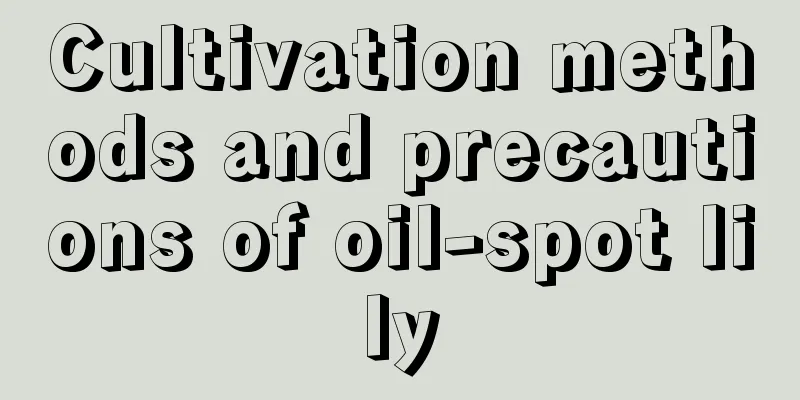Cultivation methods and precautions of oil-spot lily

1. Maintenance methods1. Soil: The preferred soil is soil with good drainage properties. Large-particle vermiculite and perlite mixed with garden soil is a good choice. The soil prepared with mixed garden soil is very suitable for its growth. 2. Light: When raising it, place it in a place with sufficient light and try to provide it with sufficient light. But make sure it is not exposed to the sun and provide adequate shade in summer. 3. Watering: Water when the soil is dry and wet when the soil is wet, but be sure to avoid water accumulation in the pot. Especially in summer, if the temperature is too high, you can also spray some water on the leaves to cool down. 4. Fertilization: Fertilizer should be applied to newly potted plants, newly planted plants, and plants that have just been repotted. In the later stages, there is no need for too strict management. Just apply a small amount every ten days or half a month. 2. Breeding techniques1. Reproduction: The more common method is division, which is also the simplest one. You only need to separate the bulb at the root and replant it. Be sure to remove the diseased leaves. 2. Pruning: If the leaves of the plant grow too lush and dense and block each other, they can be pruned appropriately by cutting off the overly large old leaves or problematic leaves. 3. Problem diagnosis and treatment1. Yellow leaves: When the leaves of the oil-spot lily turn yellow, it is basically because not enough fertilizer was given when it was potted, or the maintenance environment is not ventilated. It is best to give it sufficient nutrients and a well-ventilated environment so that it can grow better. 2. Wilting: It is quite common for the leaves of lilies to wilt and curl, which is mostly caused by too much or too little water. You can adjust the water appropriately according to your own breeding conditions. IV. Other issues1. Can it be grown indoors: It can be grown indoors. The size of the plant is very suitable for indoor placement, and the patterns on the leaves are peculiar and very attractive. Secondly, its plump bulbs are also very attractive. 2. Is it edible? The oil lily is not edible. It is a perennial herb and there is no scientific certification that it is edible. Don’t eat such a lovely plant. |
<<: Cultivation methods and precautions of mist ice jade
>>: Cultivation methods and precautions of Cinnabar Root (Wealthy Seed)
Recommend
What is the best planting time and temperature for Chinese cabbage?
Which month is suitable for planting Chinese cabb...
How to care for the fortune tree in daily life and what are the precautions
1. Plenty of sunlight The growth of the money tre...
Is the Dutch chrysanthemum suitable for a deep or shallow pot?
Should I use a deep or shallow pot for Dutch chry...
What kind of soil is suitable for potted jasmine?
Potted jasmine soil The growing soil for potted j...
How to grow white palm hydroponics to make it more vigorous
Anthurium can be grown in soil or hydroponically,...
What are the cultivation methods and precautions of wood fragrance flowers?
Introduction of wood fragrance flower The common ...
What fertilizer is best for arrowroot?
Arrowroot fertilization time Arrowroot is general...
The difference between sleeve coconut and rich coconut
1. Differences in stems The stem of the sleeve co...
The 8 most beautiful hanging flowers in the world will drive you crazy at first sight!
1 Peony Flowering period: April-June The flowers ...
Can I use soapy water to treat black spot disease of green radish?
1. Can it be used? If the green radish has black ...
How to grow Dendrobium officinale so that it blooms out of the pot?
Dendrobium candidum , also called butterfly dendr...
The difference between low snow wheels and high snow wheels
1. Differences in stems The dwarf snow wheel plan...
Where is the growth environment of Phellinus igniarius suitable for growth?
Environmental conditions for the growth of Phelli...
Can Molan be repotted in summer? How to repot it (root pruning and watering)
Can the black orchid be repotted in summer? Try n...
How to care for egg peach succulents? Cultivation methods and precautions for egg peach
The egg peach is a very beautiful succulent plant...









